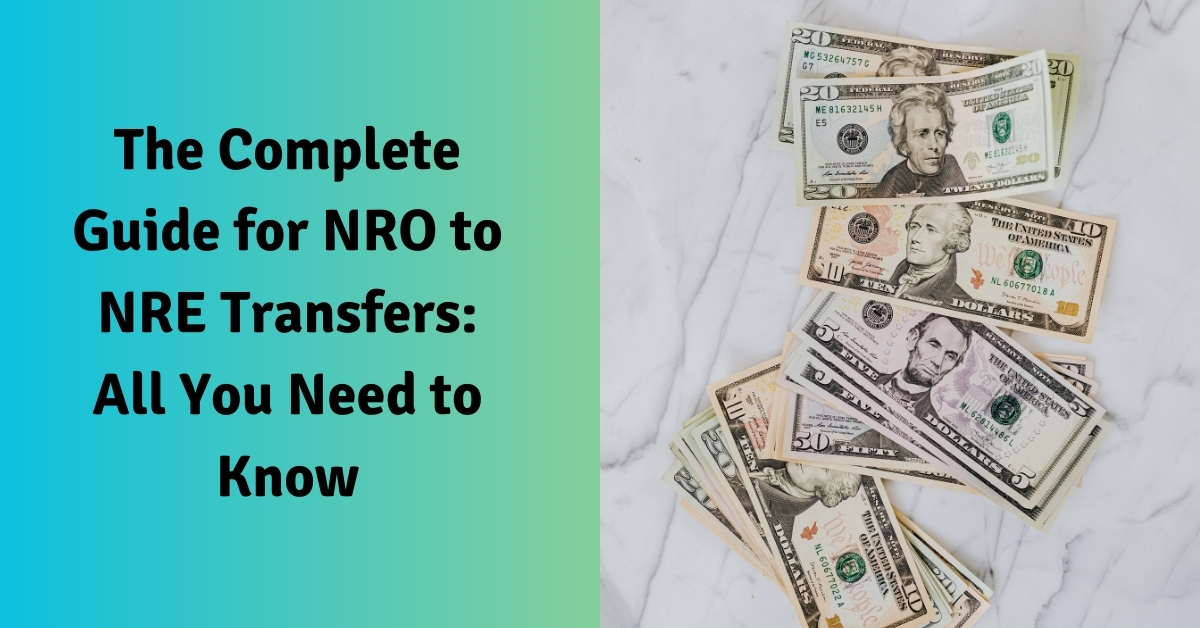The Complete Guide for NRO to NRE Transfers: All You Need to Know

For Overseas Indians, managing finances across borders often involves navigating a complex maze of banking regulations and processes. A common concern for many Overseas Indians is effectively moving money from a Non-Resident Ordinary (NRO) account to a Non-Resident External (NRE) account.
This article provides an exhaustive guide on the NRO to NRE fund movement process, incorporating all the necessary steps, regulations, and tips to make the process as smooth as possible.
Understanding NRO and NRE Accounts
Before diving into the process of moving funds from NRO to NRE accounts, it’s crucial to understand the distinct features of these accounts:
NRO Account:
This account is primarily used by Overseas Indians to manage income earned in India, such as rents, dividends, or pensions. The interest earned is subject to Indian income tax.
NRE Account:
This account is used by Overseas Indians to save their foreign earnings in Indian Rupees. The key advantage is that the interest earned is not taxable in India.
The Legality of NRO to NRE Fund Movements The Reserve Bank of India (RBI) permits moving funds from an NRO to an NRE account, subject to the fulfillment of certain conditions and adherence to the prescribed limit under the Liberalized Remittance Scheme (LRS). This move allows Overseas Indians to repatriate funds abroad more freely.
Step-by-Step Guide on NRO to NRE Fund Movement
Step 1: Understand the Regulations The RBI mandates that Overseas Indians can move funds from an NRO to an NRE account, subject to taxation and other regulations. A limit of USD 1 million per financial year applies to such movements.
Step 2: Gather Required Documents For a successful fund movement, the following documents are typically required:
Form 15CA: A declaration by the remitter confirming that tax has been paid on the moved amount.
Form 15CB: A certificate from a Chartered Accountant verifying the payment of taxes. Bank forms: Specific forms from the banks where the NRO and NRE accounts are held facilitate the fund movement.
Step 3: Submit the Forms Submit the completed Form 15CA online to the Income Tax Department and print a copy. Obtain Form 15CB from a Chartered Accountant after they verify your tax payments. Submit both forms and any required bank forms to your NRO account holding bank.
Step 4: Execute the Fund Movement Once the bank verifies the documents, the movement from your NRO to your NRE account can be initiated. Check with your bank if any additional documents or steps are required, as processes can vary slightly between banks.
Using Professional Guidance for NRO to NRE
Fund Movements Navigating through the complexities of moving funds from an NRO to an NRE account often necessitates professional guidance.
Engaging with a Chartered Accountant (CA) who is well-versed in the intricacies of Indian tax laws and RBI regulations can be invaluable.
A CA can help in accurately preparing Form 15CB, ensuring all tax liabilities are accounted for, and advising on the tax implications of the fund movement. This step is crucial not only for compliance but also for optimizing your tax liabilities.
Monitoring Tax Liabilities
One of the most critical aspects of the NRO to NRE fund movement process is the management of tax liabilities. The income deposited in NRO accounts is subject to Indian tax laws, and it’s imperative that all taxes are cleared before initiating a fund movement.
This includes ensuring that any interest earned in the NRO account is reported and taxed accordingly. Failure to comply with these tax obligations can lead to penalties and complicate the fund movement process.
Technology in Streamlining Fund Movements
In today’s digital age, many banks have started offering online facilities to simplify the NRO to NRE fund movement process. Utilizing these digital platforms can significantly reduce the paperwork and time involved.
For instance, some banks offer online submission of Form 15CA and even facilitate digital interactions with CAs for Form 15CB. Leveraging these technological advancements can make the fund movement process more efficient and less cumbersome.
Future Outlook
Easing NRO to NRE Fund Movements The Reserve Bank of India continually reviews its policies to cater to the evolving needs of Overseas Indians. There’s a growing demand for more streamlined processes and higher movement limits, and future regulations may further simplify NRO to NRE fund movements.
Staying updated on these changes is crucial for Overseas Indians looking to manage their finances effectively.
Key Considerations for NRO to NRE Fund Movement Tax Compliance:
Ensure all taxes have been paid on the funds before initiating the movement, as non-compliance can lead to legal issues.
Exchange Rates: Be aware of the current exchange rates and how they may affect the movement amount. Bank Charges: Inquire about any applicable fees or charges for the fund movement.
Can Funds Be Moved from NRO to NRE?
Yes, funds can be moved from an NRO to an NRE account, allowing Overseas Indians the flexibility to repatriate their savings outside India.
Move NRO to NRE: Bank-Specific Processes Banks may have their specific procedures for facilitating an NRO to NRE fund movement. For example, ICICI Bank customers wondering, “Can I move from NRO to NRE ICICI” should consult directly with ICICI for tailored advice and instructions, as they might offer streamlined processes or online options for their customers.
Tips for a Smooth NRO to NRE Fund Movement Early Preparation:
Begin gathering documents well in advance to avoid delays.
Tax Advice: Consult a Chartered Accountant to ensure all tax obligations are met.
Bank Consultation: Engage with both your NRO and NRE banks to understand their specific requirements and processes.
Conclusion
Moving funds from an NRO to an NRE account is a valuable facility for Overseas Indians, enabling them to repatriate their Indian earnings with ease. While the process involves several regulatory steps and documentation, understanding these requirements can help ensure a smooth fund movement.
Always stay informed about the latest RBI guidelines and bank-specific processes to leverage this facility effectively. With the right preparation and understanding, Overseas Indians can navigate the NRO to NRE fund movement process successfully, ensuring their finances are managed efficiently across borders.
FAQs’
Q1. What is an NRO account used for?
Ans- An NRO account is primarily used by Overseas Indians to manage income earned in India, such as rents, dividends, or pensions. The interest earned in this account is subject to Indian income tax.
Q2. Can funds be moved from an NRO to an NRE account?
Ans- Yes, funds can be moved from an NRO to an NRE account, subject to RBI regulations and a limit of USD 1 million per financial year.
Q3. What documents are required for an NRO to NRE fund movement?
Ans- The documents required include Form 15CA, Form 15CB certified by a Chartered Accountant, and specific bank forms from the NRO and NRE account holding banks.
Q4. What is Form 15CA and why is it needed?
Ans- Form 15CA is a declaration by the remitter confirming that tax has been paid on the moved amount. It is required to be submitted online to the Income Tax Department before the fund movement.
Q5. Do I need professional guidance for moving funds from NRO to NRE?
Ans- While engaging a Chartered Accountant can be very helpful in navigating the tax implications and ensuring compliance with RBI regulations, Vance offers 24/7 support and assistance to make NRO to NRE fund movements easier and hassle-free.
Q6. Are there any tax implications for moving funds from an NRO to an NRE account?
Ans- Yes, all taxes on the income deposited in the NRO account must be cleared before initiating the fund movement. The interest earned in the NRO account is subject to Indian income tax.
Q7. How can technology simplify the NRO to NRE fund movement process?
Ans- Many banks offer online facilities for submitting Form 15CA and digital interactions with Chartered Accountants for obtaining Form 15CB, which can significantly streamline the fund movement process and reduce paperwork.
Q8. Can I Move from NRO to NRE Without Limit?
Ans- No, the RBI has set a limit of USD 1 million per financial year for such fund movements.
Q9. Are There Taxes on NRO to NRE Fund Movements?
Ans- Yes, the moved amount must be from funds on which taxes have been paid in India.
Q10. How Long Does the Fund Movement Take?
Ans- The duration can vary based on the banks involved but typically takes a few days once all documents are verified and submitted.



